Model Procurement Plan for Goods in Agriculture in Afghanistan
VerifiedAdded on 2023/06/10
|62
|18889
|131
Thesis and Dissertation
AI Summary
This dissertation analyzes the existing constraints in the procurement planning model of the agricultural sector in Afghanistan, focusing on goods and the coordination between the Ministry of Agriculture and other organizations. The research uses both primary (surveys) and secondary data (reports, journals) to assess the current situation and propose improvements. Findings suggest the need for effective direct and indirect procurement plans to support the rural economy, with a focus on technological advancements and key components like fertilizers, pesticides, and seeds. The study emphasizes cooperative efforts between the National Procurement Authority, Ministry of Finance, and Ministry of Agriculture to enhance agricultural procurement planning for sustainable development in Afghanistan. Desklib provides access to similar solved assignments and resources for students.
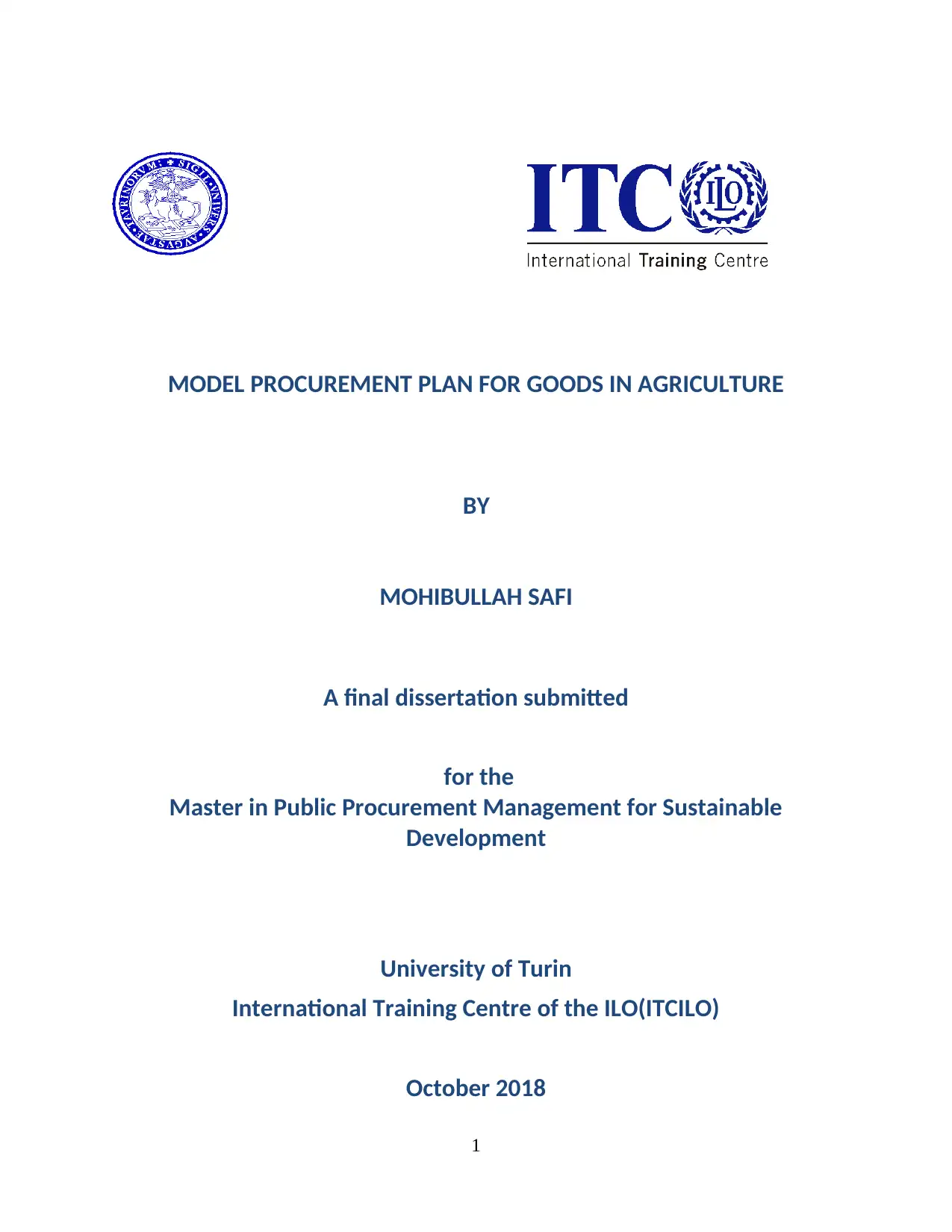
MODEL PROCUREMENT PLAN FOR GOODS IN AGRICULTURE
BY
MOHIBULLAH SAFI
A final dissertation submitted
for the
Master in Public Procurement Management for Sustainable
Development
University of Turin
International Training Centre of the ILO(ITCILO)
October 2018
1
BY
MOHIBULLAH SAFI
A final dissertation submitted
for the
Master in Public Procurement Management for Sustainable
Development
University of Turin
International Training Centre of the ILO(ITCILO)
October 2018
1
Paraphrase This Document
Need a fresh take? Get an instant paraphrase of this document with our AI Paraphraser
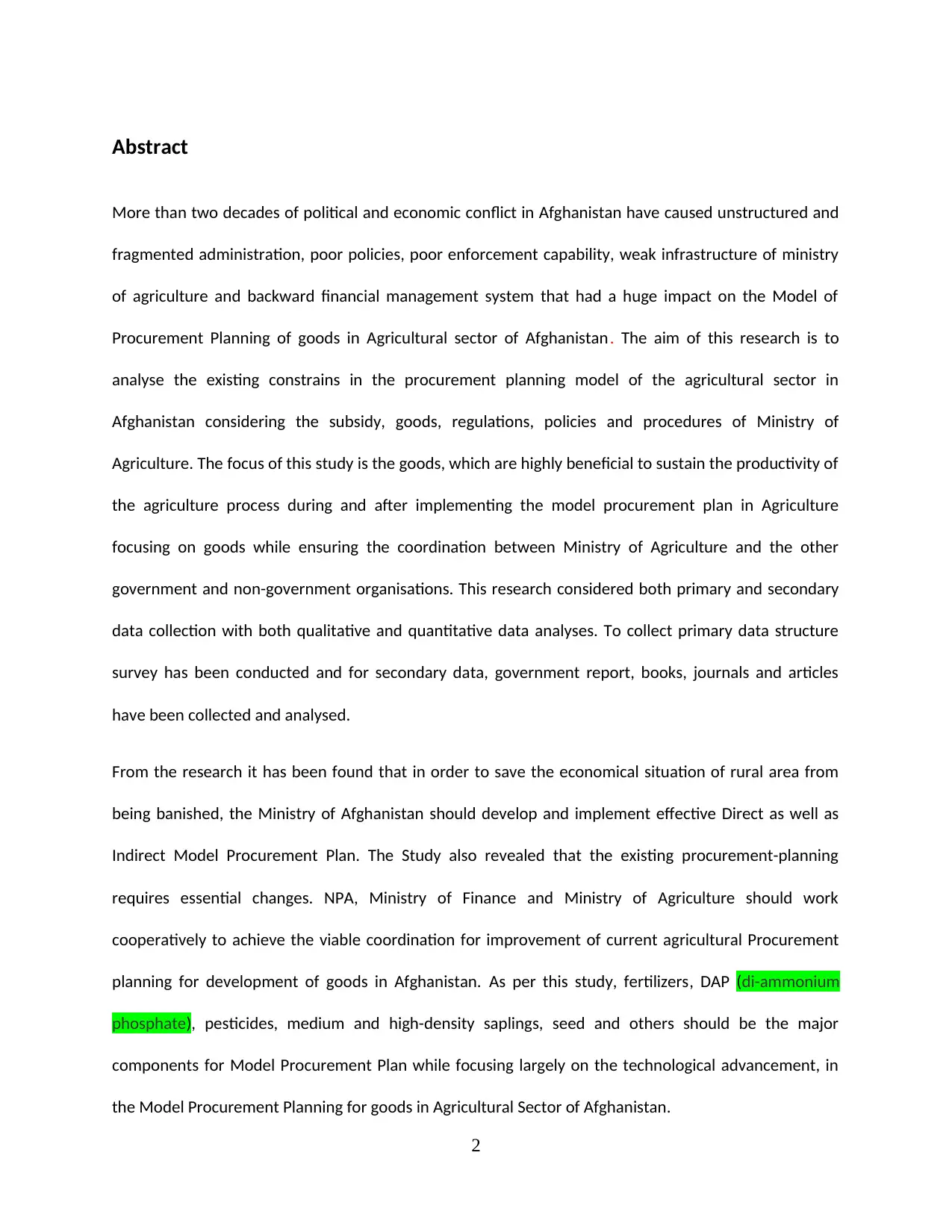
Abstract
More than two decades of political and economic conflict in Afghanistan have caused unstructured and
fragmented administration, poor policies, poor enforcement capability, weak infrastructure of ministry
of agriculture and backward financial management system that had a huge impact on the Model of
Procurement Planning of goods in Agricultural sector of Afghanistan. The aim of this research is to
analyse the existing constrains in the procurement planning model of the agricultural sector in
Afghanistan considering the subsidy, goods, regulations, policies and procedures of Ministry of
Agriculture. The focus of this study is the goods, which are highly beneficial to sustain the productivity of
the agriculture process during and after implementing the model procurement plan in Agriculture
focusing on goods while ensuring the coordination between Ministry of Agriculture and the other
government and non-government organisations. This research considered both primary and secondary
data collection with both qualitative and quantitative data analyses. To collect primary data structure
survey has been conducted and for secondary data, government report, books, journals and articles
have been collected and analysed.
From the research it has been found that in order to save the economical situation of rural area from
being banished, the Ministry of Afghanistan should develop and implement effective Direct as well as
Indirect Model Procurement Plan. The Study also revealed that the existing procurement-planning
requires essential changes. NPA, Ministry of Finance and Ministry of Agriculture should work
cooperatively to achieve the viable coordination for improvement of current agricultural Procurement
planning for development of goods in Afghanistan. As per this study, fertilizers, DAP (di-ammonium
phosphate), pesticides, medium and high-density saplings, seed and others should be the major
components for Model Procurement Plan while focusing largely on the technological advancement, in
the Model Procurement Planning for goods in Agricultural Sector of Afghanistan.
2
More than two decades of political and economic conflict in Afghanistan have caused unstructured and
fragmented administration, poor policies, poor enforcement capability, weak infrastructure of ministry
of agriculture and backward financial management system that had a huge impact on the Model of
Procurement Planning of goods in Agricultural sector of Afghanistan. The aim of this research is to
analyse the existing constrains in the procurement planning model of the agricultural sector in
Afghanistan considering the subsidy, goods, regulations, policies and procedures of Ministry of
Agriculture. The focus of this study is the goods, which are highly beneficial to sustain the productivity of
the agriculture process during and after implementing the model procurement plan in Agriculture
focusing on goods while ensuring the coordination between Ministry of Agriculture and the other
government and non-government organisations. This research considered both primary and secondary
data collection with both qualitative and quantitative data analyses. To collect primary data structure
survey has been conducted and for secondary data, government report, books, journals and articles
have been collected and analysed.
From the research it has been found that in order to save the economical situation of rural area from
being banished, the Ministry of Afghanistan should develop and implement effective Direct as well as
Indirect Model Procurement Plan. The Study also revealed that the existing procurement-planning
requires essential changes. NPA, Ministry of Finance and Ministry of Agriculture should work
cooperatively to achieve the viable coordination for improvement of current agricultural Procurement
planning for development of goods in Afghanistan. As per this study, fertilizers, DAP (di-ammonium
phosphate), pesticides, medium and high-density saplings, seed and others should be the major
components for Model Procurement Plan while focusing largely on the technological advancement, in
the Model Procurement Planning for goods in Agricultural Sector of Afghanistan.
2
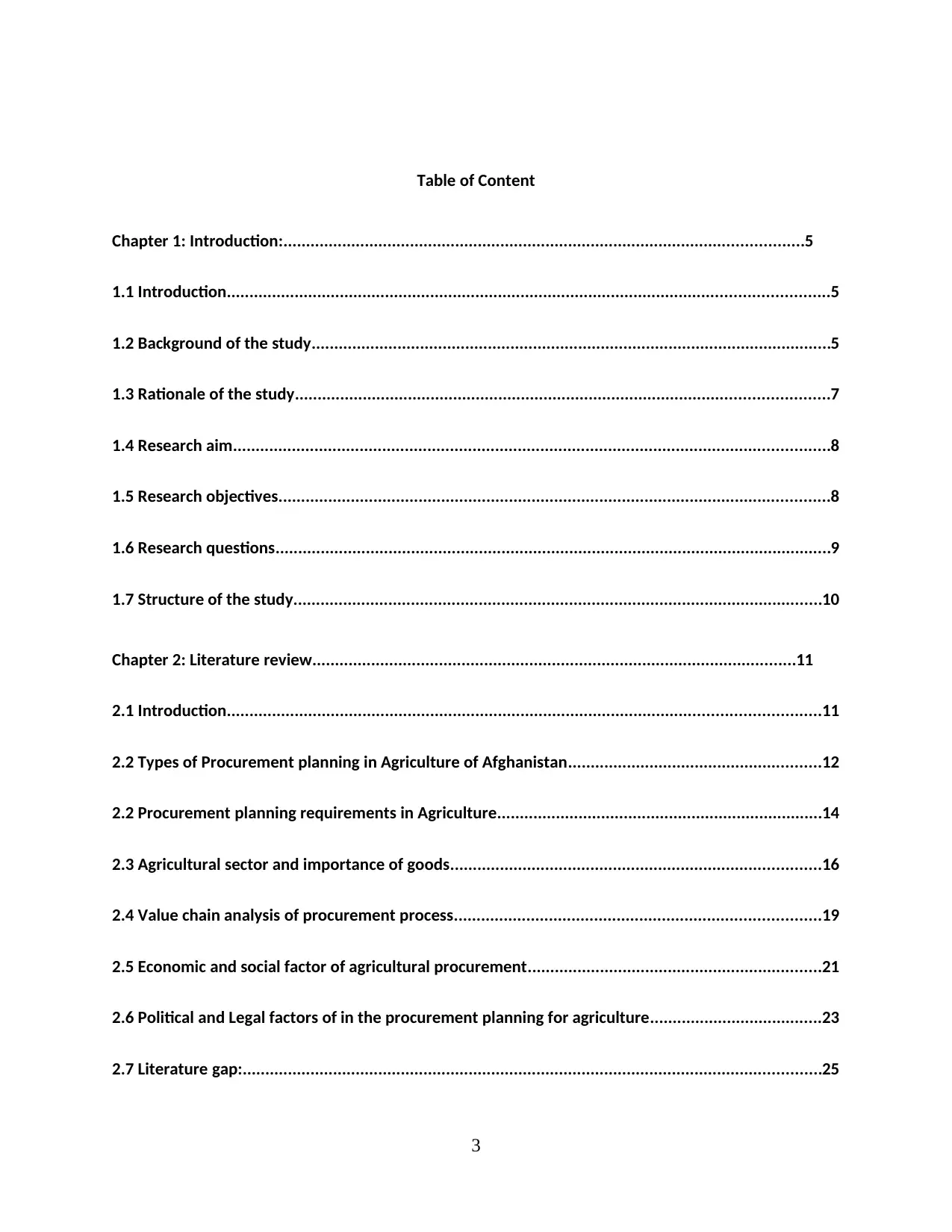
Table of Content
Chapter 1: Introduction:...................................................................................................................5
1.1 Introduction.....................................................................................................................................5
1.2 Background of the study...................................................................................................................5
1.3 Rationale of the study......................................................................................................................7
1.4 Research aim....................................................................................................................................8
1.5 Research objectives..........................................................................................................................8
1.6 Research questions...........................................................................................................................9
1.7 Structure of the study.....................................................................................................................10
Chapter 2: Literature review...........................................................................................................11
2.1 Introduction...................................................................................................................................11
2.2 Types of Procurement planning in Agriculture of Afghanistan........................................................12
2.2 Procurement planning requirements in Agriculture........................................................................14
2.3 Agricultural sector and importance of goods..................................................................................16
2.4 Value chain analysis of procurement process.................................................................................19
2.5 Economic and social factor of agricultural procurement.................................................................21
2.6 Political and Legal factors of in the procurement planning for agriculture......................................23
2.7 Literature gap:................................................................................................................................25
3
Chapter 1: Introduction:...................................................................................................................5
1.1 Introduction.....................................................................................................................................5
1.2 Background of the study...................................................................................................................5
1.3 Rationale of the study......................................................................................................................7
1.4 Research aim....................................................................................................................................8
1.5 Research objectives..........................................................................................................................8
1.6 Research questions...........................................................................................................................9
1.7 Structure of the study.....................................................................................................................10
Chapter 2: Literature review...........................................................................................................11
2.1 Introduction...................................................................................................................................11
2.2 Types of Procurement planning in Agriculture of Afghanistan........................................................12
2.2 Procurement planning requirements in Agriculture........................................................................14
2.3 Agricultural sector and importance of goods..................................................................................16
2.4 Value chain analysis of procurement process.................................................................................19
2.5 Economic and social factor of agricultural procurement.................................................................21
2.6 Political and Legal factors of in the procurement planning for agriculture......................................23
2.7 Literature gap:................................................................................................................................25
3
⊘ This is a preview!⊘
Do you want full access?
Subscribe today to unlock all pages.

Trusted by 1+ million students worldwide
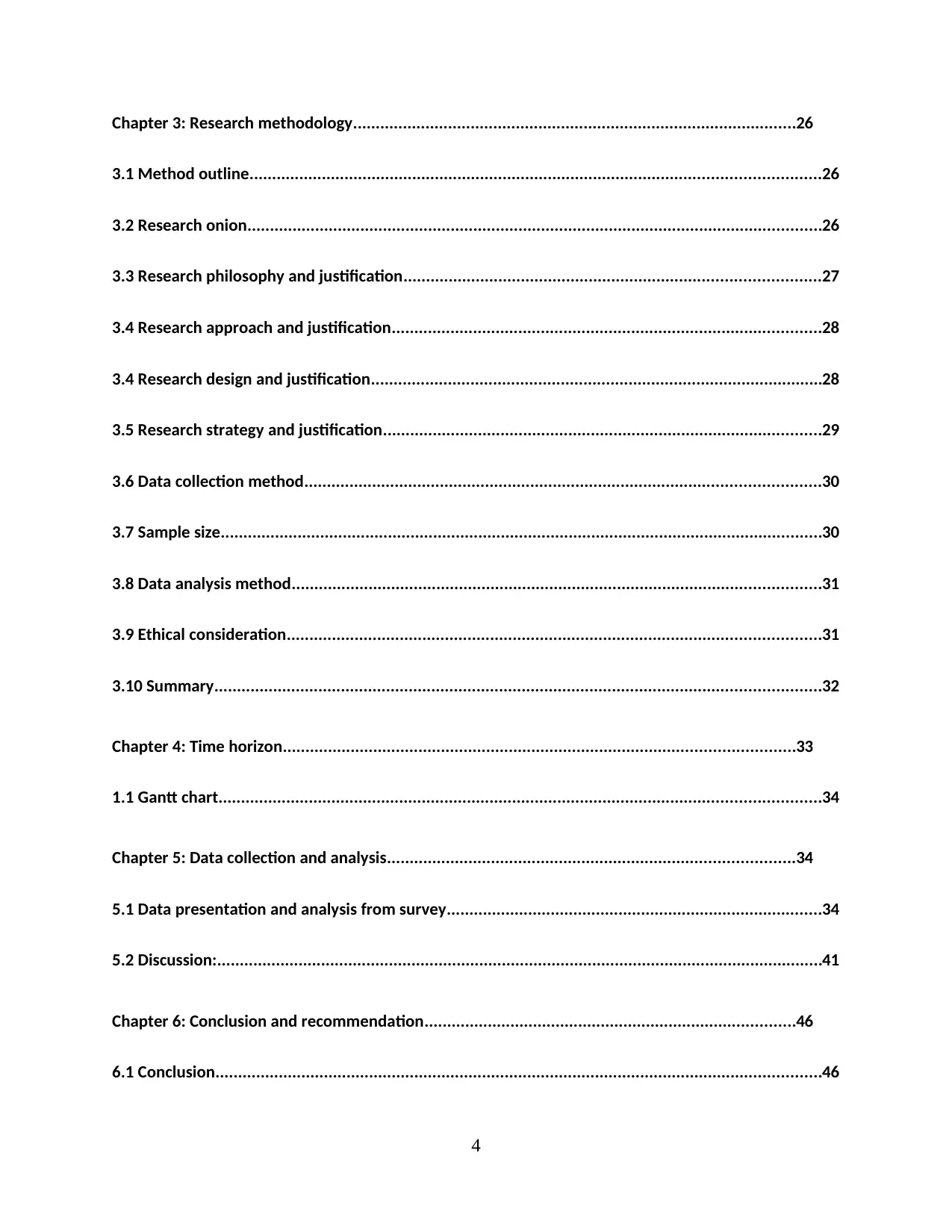
Chapter 3: Research methodology..................................................................................................26
3.1 Method outline..............................................................................................................................26
3.2 Research onion...............................................................................................................................26
3.3 Research philosophy and justification............................................................................................27
3.4 Research approach and justification...............................................................................................28
3.4 Research design and justification....................................................................................................28
3.5 Research strategy and justification.................................................................................................29
3.6 Data collection method..................................................................................................................30
3.7 Sample size.....................................................................................................................................30
3.8 Data analysis method.....................................................................................................................31
3.9 Ethical consideration......................................................................................................................31
3.10 Summary......................................................................................................................................32
Chapter 4: Time horizon.................................................................................................................33
1.1 Gantt chart.....................................................................................................................................34
Chapter 5: Data collection and analysis..........................................................................................34
5.1 Data presentation and analysis from survey...................................................................................34
5.2 Discussion:......................................................................................................................................41
Chapter 6: Conclusion and recommendation..................................................................................46
6.1 Conclusion......................................................................................................................................46
4
3.1 Method outline..............................................................................................................................26
3.2 Research onion...............................................................................................................................26
3.3 Research philosophy and justification............................................................................................27
3.4 Research approach and justification...............................................................................................28
3.4 Research design and justification....................................................................................................28
3.5 Research strategy and justification.................................................................................................29
3.6 Data collection method..................................................................................................................30
3.7 Sample size.....................................................................................................................................30
3.8 Data analysis method.....................................................................................................................31
3.9 Ethical consideration......................................................................................................................31
3.10 Summary......................................................................................................................................32
Chapter 4: Time horizon.................................................................................................................33
1.1 Gantt chart.....................................................................................................................................34
Chapter 5: Data collection and analysis..........................................................................................34
5.1 Data presentation and analysis from survey...................................................................................34
5.2 Discussion:......................................................................................................................................41
Chapter 6: Conclusion and recommendation..................................................................................46
6.1 Conclusion......................................................................................................................................46
4
Paraphrase This Document
Need a fresh take? Get an instant paraphrase of this document with our AI Paraphraser
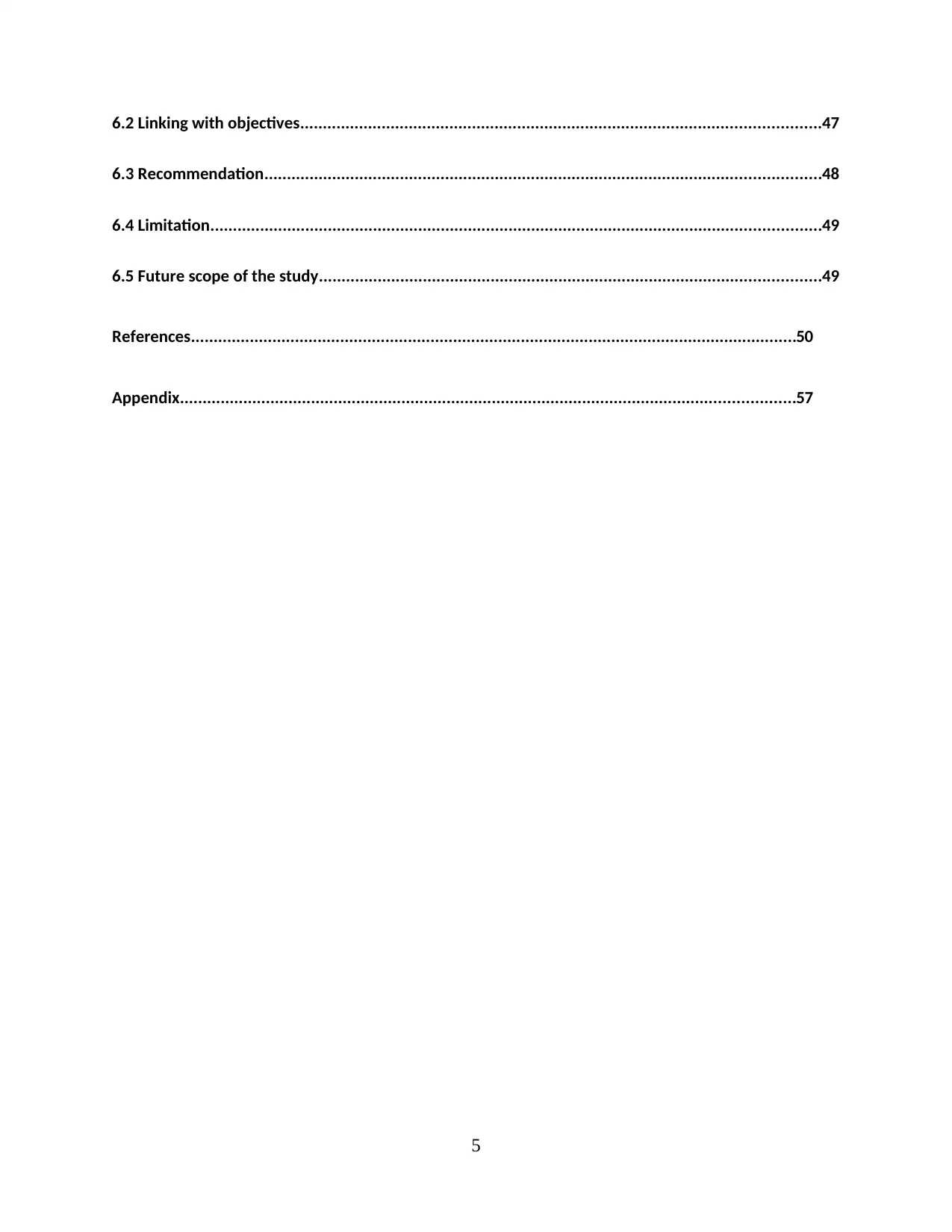
6.2 Linking with objectives...................................................................................................................47
6.3 Recommendation...........................................................................................................................48
6.4 Limitation.......................................................................................................................................49
6.5 Future scope of the study...............................................................................................................49
References......................................................................................................................................50
Appendix........................................................................................................................................57
5
6.3 Recommendation...........................................................................................................................48
6.4 Limitation.......................................................................................................................................49
6.5 Future scope of the study...............................................................................................................49
References......................................................................................................................................50
Appendix........................................................................................................................................57
5
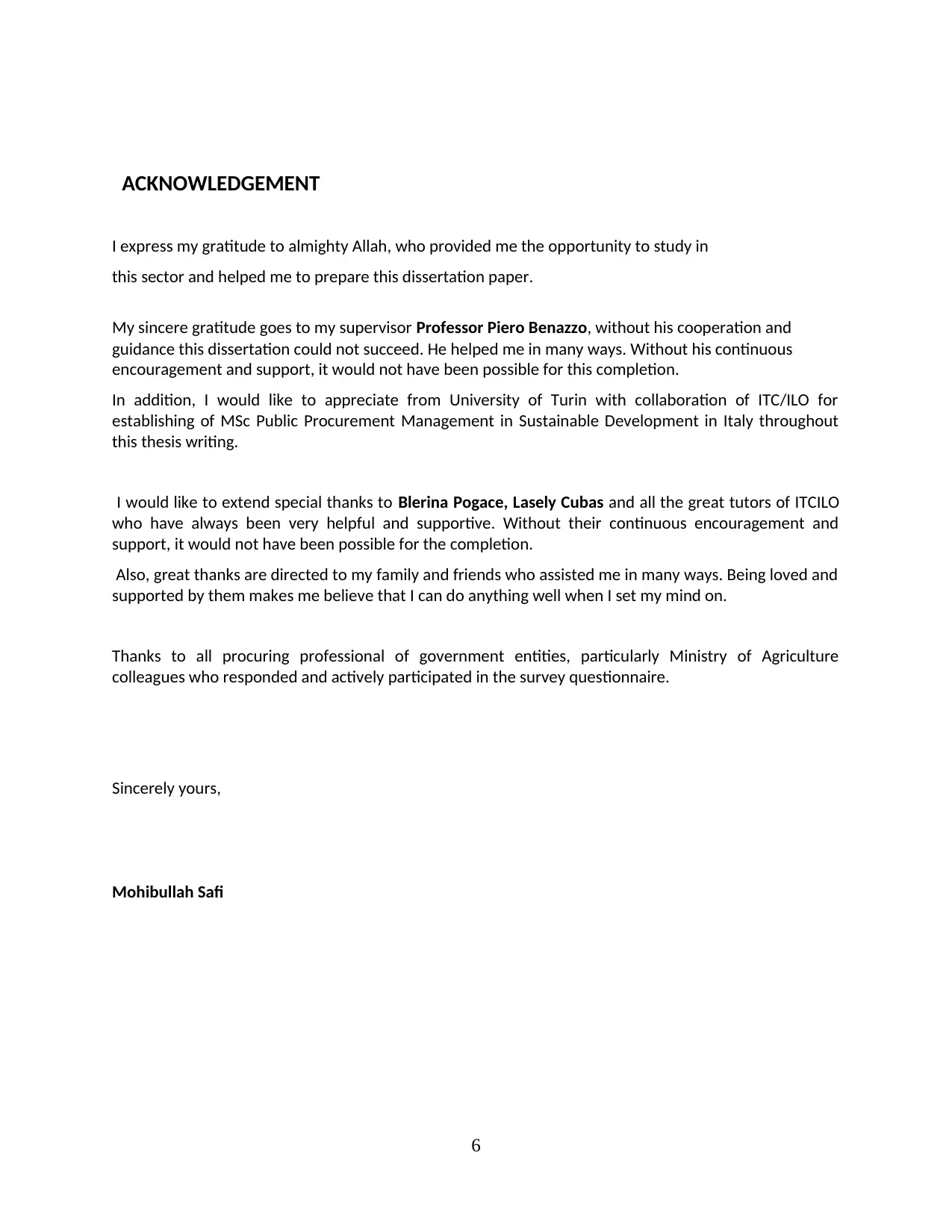
ACKNOWLEDGEMENT
I express my gratitude to almighty Allah, who provided me the opportunity to study in
this sector and helped me to prepare this dissertation paper.
My sincere gratitude goes to my supervisor Professor Piero Benazzo, without his cooperation and
guidance this dissertation could not succeed. He helped me in many ways. Without his continuous
encouragement and support, it would not have been possible for this completion.
In addition, I would like to appreciate from University of Turin with collaboration of ITC/ILO for
establishing of MSc Public Procurement Management in Sustainable Development in Italy throughout
this thesis writing.
I would like to extend special thanks to Blerina Pogace, Lasely Cubas and all the great tutors of ITCILO
who have always been very helpful and supportive. Without their continuous encouragement and
support, it would not have been possible for the completion.
Also, great thanks are directed to my family and friends who assisted me in many ways. Being loved and
supported by them makes me believe that I can do anything well when I set my mind on.
Thanks to all procuring professional of government entities, particularly Ministry of Agriculture
colleagues who responded and actively participated in the survey questionnaire.
Sincerely yours,
Mohibullah Safi
6
I express my gratitude to almighty Allah, who provided me the opportunity to study in
this sector and helped me to prepare this dissertation paper.
My sincere gratitude goes to my supervisor Professor Piero Benazzo, without his cooperation and
guidance this dissertation could not succeed. He helped me in many ways. Without his continuous
encouragement and support, it would not have been possible for this completion.
In addition, I would like to appreciate from University of Turin with collaboration of ITC/ILO for
establishing of MSc Public Procurement Management in Sustainable Development in Italy throughout
this thesis writing.
I would like to extend special thanks to Blerina Pogace, Lasely Cubas and all the great tutors of ITCILO
who have always been very helpful and supportive. Without their continuous encouragement and
support, it would not have been possible for the completion.
Also, great thanks are directed to my family and friends who assisted me in many ways. Being loved and
supported by them makes me believe that I can do anything well when I set my mind on.
Thanks to all procuring professional of government entities, particularly Ministry of Agriculture
colleagues who responded and actively participated in the survey questionnaire.
Sincerely yours,
Mohibullah Safi
6
⊘ This is a preview!⊘
Do you want full access?
Subscribe today to unlock all pages.

Trusted by 1+ million students worldwide
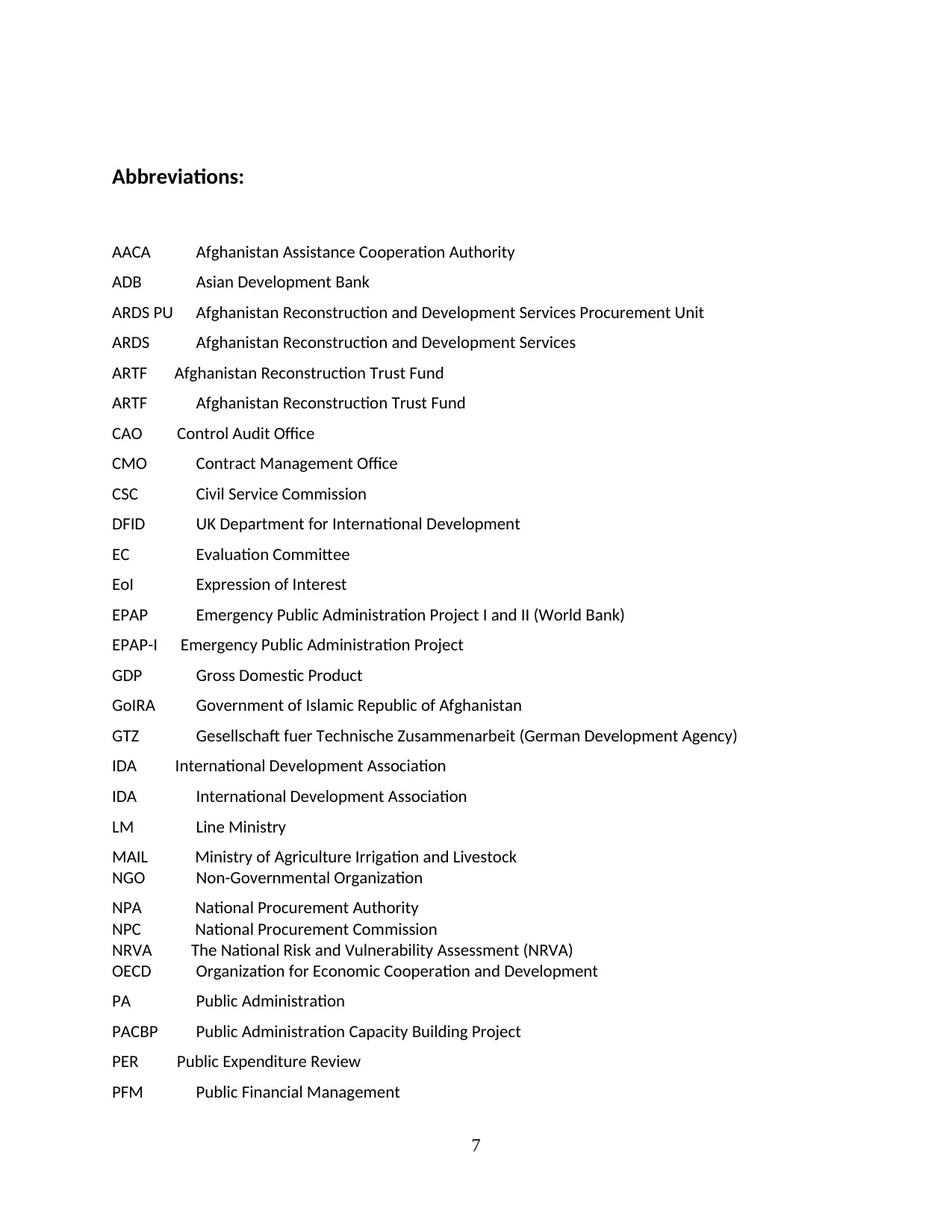
Abbreviations:
AACA Afghanistan Assistance Cooperation Authority
ADB Asian Development Bank
ARDS PU Afghanistan Reconstruction and Development Services Procurement Unit
ARDS Afghanistan Reconstruction and Development Services
ARTF Afghanistan Reconstruction Trust Fund
ARTF Afghanistan Reconstruction Trust Fund
CAO Control Audit Office
CMO Contract Management Office
CSC Civil Service Commission
DFID UK Department for International Development
EC Evaluation Committee
EoI Expression of Interest
EPAP Emergency Public Administration Project I and II (World Bank)
EPAP-I Emergency Public Administration Project
GDP Gross Domestic Product
GoIRA Government of Islamic Republic of Afghanistan
GTZ Gesellschaft fuer Technische Zusammenarbeit (German Development Agency)
IDA International Development Association
IDA International Development Association
LM Line Ministry
MAIL Ministry of Agriculture Irrigation and Livestock
NGO Non-Governmental Organization
NPA National Procurement Authority
NPC National Procurement Commission
NRVA The National Risk and Vulnerability Assessment (NRVA)
OECD Organization for Economic Cooperation and Development
PA Public Administration
PACBP Public Administration Capacity Building Project
PER Public Expenditure Review
PFM Public Financial Management
7
AACA Afghanistan Assistance Cooperation Authority
ADB Asian Development Bank
ARDS PU Afghanistan Reconstruction and Development Services Procurement Unit
ARDS Afghanistan Reconstruction and Development Services
ARTF Afghanistan Reconstruction Trust Fund
ARTF Afghanistan Reconstruction Trust Fund
CAO Control Audit Office
CMO Contract Management Office
CSC Civil Service Commission
DFID UK Department for International Development
EC Evaluation Committee
EoI Expression of Interest
EPAP Emergency Public Administration Project I and II (World Bank)
EPAP-I Emergency Public Administration Project
GDP Gross Domestic Product
GoIRA Government of Islamic Republic of Afghanistan
GTZ Gesellschaft fuer Technische Zusammenarbeit (German Development Agency)
IDA International Development Association
IDA International Development Association
LM Line Ministry
MAIL Ministry of Agriculture Irrigation and Livestock
NGO Non-Governmental Organization
NPA National Procurement Authority
NPC National Procurement Commission
NRVA The National Risk and Vulnerability Assessment (NRVA)
OECD Organization for Economic Cooperation and Development
PA Public Administration
PACBP Public Administration Capacity Building Project
PER Public Expenditure Review
PFM Public Financial Management
7
Paraphrase This Document
Need a fresh take? Get an instant paraphrase of this document with our AI Paraphraser
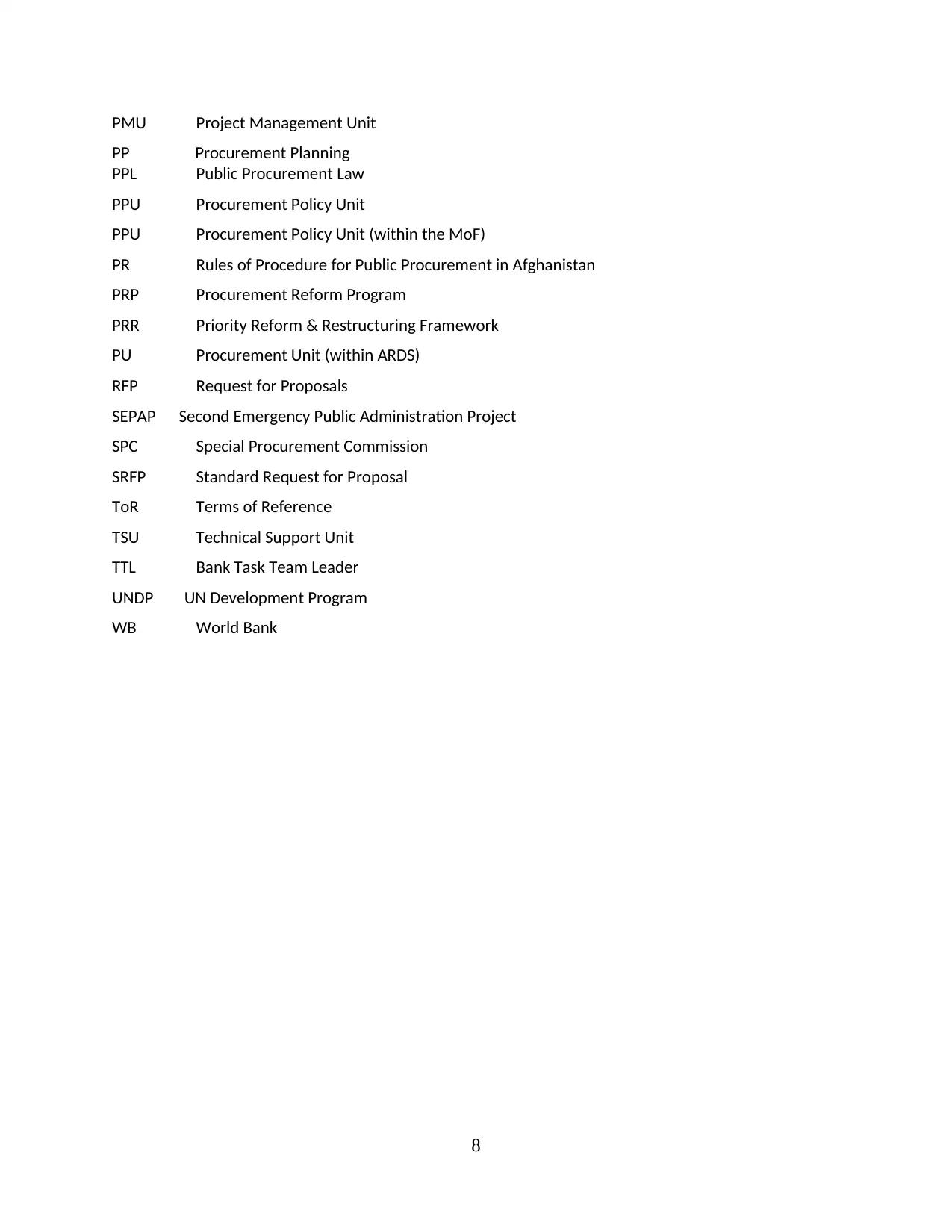
PMU Project Management Unit
PP Procurement Planning
PPL Public Procurement Law
PPU Procurement Policy Unit
PPU Procurement Policy Unit (within the MoF)
PR Rules of Procedure for Public Procurement in Afghanistan
PRP Procurement Reform Program
PRR Priority Reform & Restructuring Framework
PU Procurement Unit (within ARDS)
RFP Request for Proposals
SEPAP Second Emergency Public Administration Project
SPC Special Procurement Commission
SRFP Standard Request for Proposal
ToR Terms of Reference
TSU Technical Support Unit
TTL Bank Task Team Leader
UNDP UN Development Program
WB World Bank
8
PP Procurement Planning
PPL Public Procurement Law
PPU Procurement Policy Unit
PPU Procurement Policy Unit (within the MoF)
PR Rules of Procedure for Public Procurement in Afghanistan
PRP Procurement Reform Program
PRR Priority Reform & Restructuring Framework
PU Procurement Unit (within ARDS)
RFP Request for Proposals
SEPAP Second Emergency Public Administration Project
SPC Special Procurement Commission
SRFP Standard Request for Proposal
ToR Terms of Reference
TSU Technical Support Unit
TTL Bank Task Team Leader
UNDP UN Development Program
WB World Bank
8
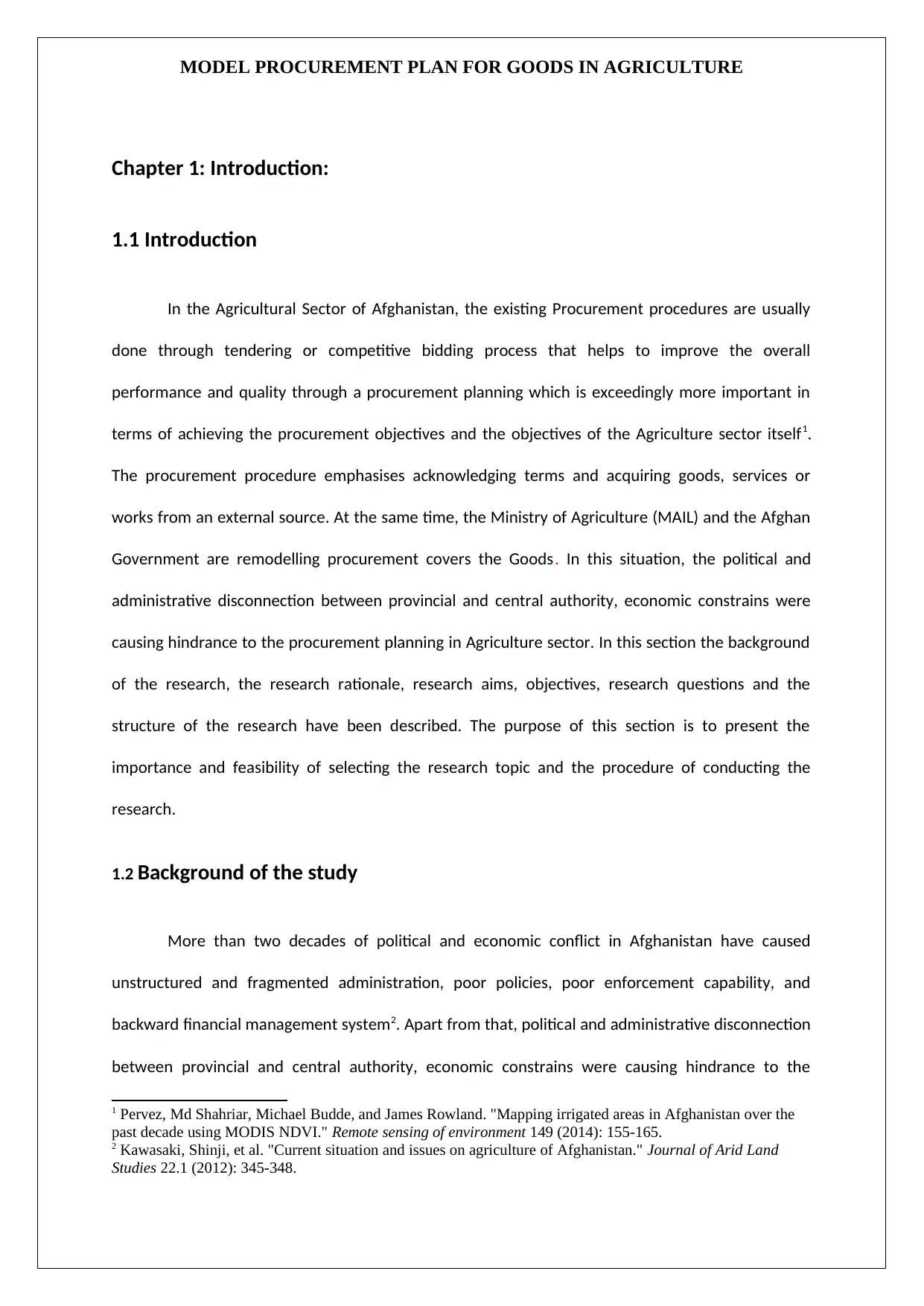
MODEL PROCUREMENT PLAN FOR GOODS IN AGRICULTURE
Chapter 1: Introduction:
1.1 Introduction
In the Agricultural Sector of Afghanistan, the existing Procurement procedures are usually
done through tendering or competitive bidding process that helps to improve the overall
performance and quality through a procurement planning which is exceedingly more important in
terms of achieving the procurement objectives and the objectives of the Agriculture sector itself1.
The procurement procedure emphasises acknowledging terms and acquiring goods, services or
works from an external source. At the same time, the Ministry of Agriculture (MAIL) and the Afghan
Government are remodelling procurement covers the Goods. In this situation, the political and
administrative disconnection between provincial and central authority, economic constrains were
causing hindrance to the procurement planning in Agriculture sector. In this section the background
of the research, the research rationale, research aims, objectives, research questions and the
structure of the research have been described. The purpose of this section is to present the
importance and feasibility of selecting the research topic and the procedure of conducting the
research.
1.2 Background of the study
More than two decades of political and economic conflict in Afghanistan have caused
unstructured and fragmented administration, poor policies, poor enforcement capability, and
backward financial management system2. Apart from that, political and administrative disconnection
between provincial and central authority, economic constrains were causing hindrance to the
1 Pervez, Md Shahriar, Michael Budde, and James Rowland. "Mapping irrigated areas in Afghanistan over the
past decade using MODIS NDVI." Remote sensing of environment 149 (2014): 155-165.
2 Kawasaki, Shinji, et al. "Current situation and issues on agriculture of Afghanistan." Journal of Arid Land
Studies 22.1 (2012): 345-348.
Chapter 1: Introduction:
1.1 Introduction
In the Agricultural Sector of Afghanistan, the existing Procurement procedures are usually
done through tendering or competitive bidding process that helps to improve the overall
performance and quality through a procurement planning which is exceedingly more important in
terms of achieving the procurement objectives and the objectives of the Agriculture sector itself1.
The procurement procedure emphasises acknowledging terms and acquiring goods, services or
works from an external source. At the same time, the Ministry of Agriculture (MAIL) and the Afghan
Government are remodelling procurement covers the Goods. In this situation, the political and
administrative disconnection between provincial and central authority, economic constrains were
causing hindrance to the procurement planning in Agriculture sector. In this section the background
of the research, the research rationale, research aims, objectives, research questions and the
structure of the research have been described. The purpose of this section is to present the
importance and feasibility of selecting the research topic and the procedure of conducting the
research.
1.2 Background of the study
More than two decades of political and economic conflict in Afghanistan have caused
unstructured and fragmented administration, poor policies, poor enforcement capability, and
backward financial management system2. Apart from that, political and administrative disconnection
between provincial and central authority, economic constrains were causing hindrance to the
1 Pervez, Md Shahriar, Michael Budde, and James Rowland. "Mapping irrigated areas in Afghanistan over the
past decade using MODIS NDVI." Remote sensing of environment 149 (2014): 155-165.
2 Kawasaki, Shinji, et al. "Current situation and issues on agriculture of Afghanistan." Journal of Arid Land
Studies 22.1 (2012): 345-348.
⊘ This is a preview!⊘
Do you want full access?
Subscribe today to unlock all pages.

Trusted by 1+ million students worldwide
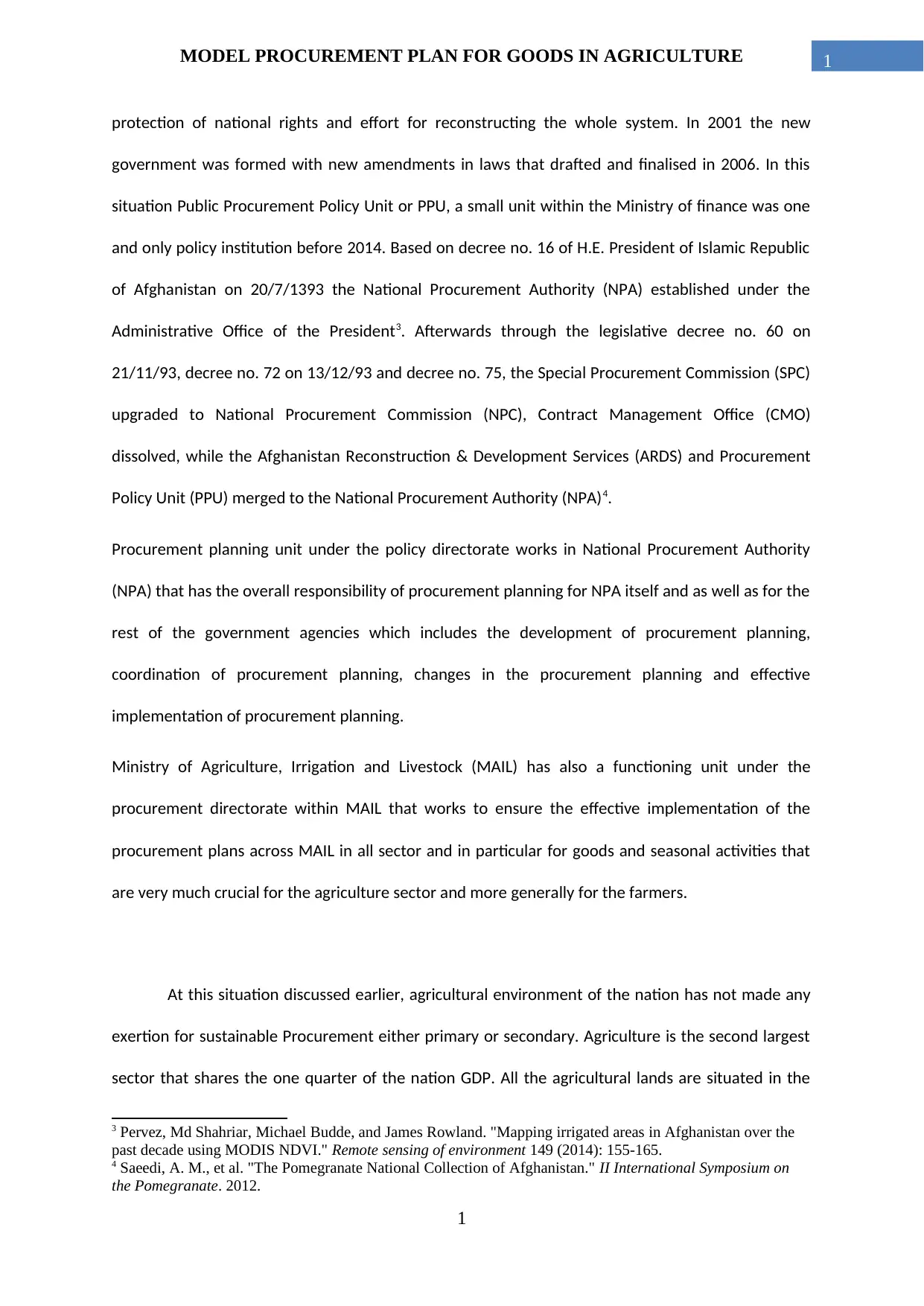
MODEL PROCUREMENT PLAN FOR GOODS IN AGRICULTURE 1
protection of national rights and effort for reconstructing the whole system. In 2001 the new
government was formed with new amendments in laws that drafted and finalised in 2006. In this
situation Public Procurement Policy Unit or PPU, a small unit within the Ministry of finance was one
and only policy institution before 2014. Based on decree no. 16 of H.E. President of Islamic Republic
of Afghanistan on 20/7/1393 the National Procurement Authority (NPA) established under the
Administrative Office of the President3. Afterwards through the legislative decree no. 60 on
21/11/93, decree no. 72 on 13/12/93 and decree no. 75, the Special Procurement Commission (SPC)
upgraded to National Procurement Commission (NPC), Contract Management Office (CMO)
dissolved, while the Afghanistan Reconstruction & Development Services (ARDS) and Procurement
Policy Unit (PPU) merged to the National Procurement Authority (NPA)4.
Procurement planning unit under the policy directorate works in National Procurement Authority
(NPA) that has the overall responsibility of procurement planning for NPA itself and as well as for the
rest of the government agencies which includes the development of procurement planning,
coordination of procurement planning, changes in the procurement planning and effective
implementation of procurement planning.
Ministry of Agriculture, Irrigation and Livestock (MAIL) has also a functioning unit under the
procurement directorate within MAIL that works to ensure the effective implementation of the
procurement plans across MAIL in all sector and in particular for goods and seasonal activities that
are very much crucial for the agriculture sector and more generally for the farmers.
At this situation discussed earlier, agricultural environment of the nation has not made any
exertion for sustainable Procurement either primary or secondary. Agriculture is the second largest
sector that shares the one quarter of the nation GDP. All the agricultural lands are situated in the
3 Pervez, Md Shahriar, Michael Budde, and James Rowland. "Mapping irrigated areas in Afghanistan over the
past decade using MODIS NDVI." Remote sensing of environment 149 (2014): 155-165.
4 Saeedi, A. M., et al. "The Pomegranate National Collection of Afghanistan." II International Symposium on
the Pomegranate. 2012.
1
protection of national rights and effort for reconstructing the whole system. In 2001 the new
government was formed with new amendments in laws that drafted and finalised in 2006. In this
situation Public Procurement Policy Unit or PPU, a small unit within the Ministry of finance was one
and only policy institution before 2014. Based on decree no. 16 of H.E. President of Islamic Republic
of Afghanistan on 20/7/1393 the National Procurement Authority (NPA) established under the
Administrative Office of the President3. Afterwards through the legislative decree no. 60 on
21/11/93, decree no. 72 on 13/12/93 and decree no. 75, the Special Procurement Commission (SPC)
upgraded to National Procurement Commission (NPC), Contract Management Office (CMO)
dissolved, while the Afghanistan Reconstruction & Development Services (ARDS) and Procurement
Policy Unit (PPU) merged to the National Procurement Authority (NPA)4.
Procurement planning unit under the policy directorate works in National Procurement Authority
(NPA) that has the overall responsibility of procurement planning for NPA itself and as well as for the
rest of the government agencies which includes the development of procurement planning,
coordination of procurement planning, changes in the procurement planning and effective
implementation of procurement planning.
Ministry of Agriculture, Irrigation and Livestock (MAIL) has also a functioning unit under the
procurement directorate within MAIL that works to ensure the effective implementation of the
procurement plans across MAIL in all sector and in particular for goods and seasonal activities that
are very much crucial for the agriculture sector and more generally for the farmers.
At this situation discussed earlier, agricultural environment of the nation has not made any
exertion for sustainable Procurement either primary or secondary. Agriculture is the second largest
sector that shares the one quarter of the nation GDP. All the agricultural lands are situated in the
3 Pervez, Md Shahriar, Michael Budde, and James Rowland. "Mapping irrigated areas in Afghanistan over the
past decade using MODIS NDVI." Remote sensing of environment 149 (2014): 155-165.
4 Saeedi, A. M., et al. "The Pomegranate National Collection of Afghanistan." II International Symposium on
the Pomegranate. 2012.
1
Paraphrase This Document
Need a fresh take? Get an instant paraphrase of this document with our AI Paraphraser
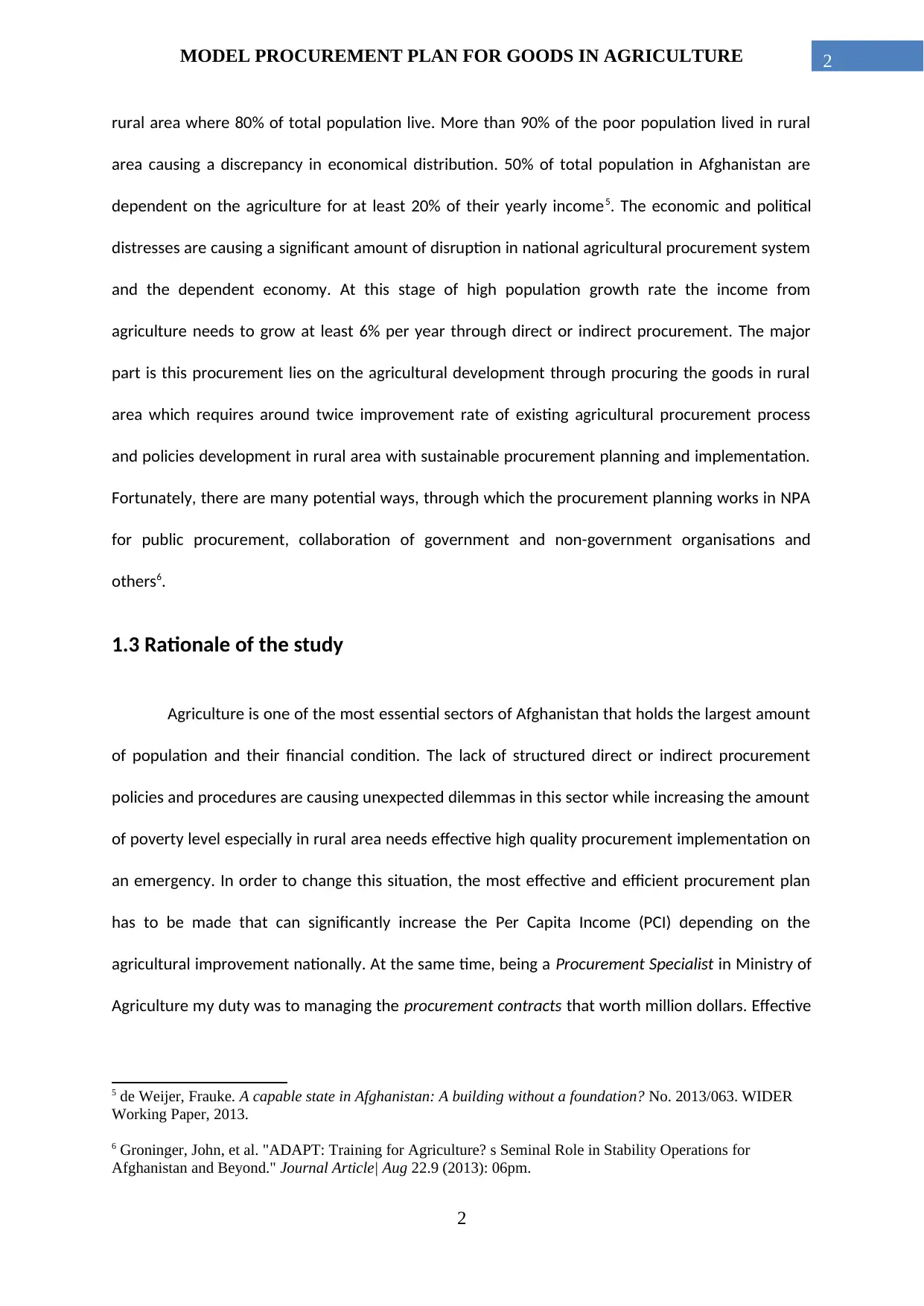
2MODEL PROCUREMENT PLAN FOR GOODS IN AGRICULTURE
rural area where 80% of total population live. More than 90% of the poor population lived in rural
area causing a discrepancy in economical distribution. 50% of total population in Afghanistan are
dependent on the agriculture for at least 20% of their yearly income5. The economic and political
distresses are causing a significant amount of disruption in national agricultural procurement system
and the dependent economy. At this stage of high population growth rate the income from
agriculture needs to grow at least 6% per year through direct or indirect procurement. The major
part is this procurement lies on the agricultural development through procuring the goods in rural
area which requires around twice improvement rate of existing agricultural procurement process
and policies development in rural area with sustainable procurement planning and implementation.
Fortunately, there are many potential ways, through which the procurement planning works in NPA
for public procurement, collaboration of government and non-government organisations and
others6.
1.3 Rationale of the study
Agriculture is one of the most essential sectors of Afghanistan that holds the largest amount
of population and their financial condition. The lack of structured direct or indirect procurement
policies and procedures are causing unexpected dilemmas in this sector while increasing the amount
of poverty level especially in rural area needs effective high quality procurement implementation on
an emergency. In order to change this situation, the most effective and efficient procurement plan
has to be made that can significantly increase the Per Capita Income (PCI) depending on the
agricultural improvement nationally. At the same time, being a Procurement Specialist in Ministry of
Agriculture my duty was to managing the procurement contracts that worth million dollars. Effective
5 de Weijer, Frauke. A capable state in Afghanistan: A building without a foundation? No. 2013/063. WIDER
Working Paper, 2013.
6 Groninger, John, et al. "ADAPT: Training for Agriculture? s Seminal Role in Stability Operations for
Afghanistan and Beyond." Journal Article| Aug 22.9 (2013): 06pm.
2
rural area where 80% of total population live. More than 90% of the poor population lived in rural
area causing a discrepancy in economical distribution. 50% of total population in Afghanistan are
dependent on the agriculture for at least 20% of their yearly income5. The economic and political
distresses are causing a significant amount of disruption in national agricultural procurement system
and the dependent economy. At this stage of high population growth rate the income from
agriculture needs to grow at least 6% per year through direct or indirect procurement. The major
part is this procurement lies on the agricultural development through procuring the goods in rural
area which requires around twice improvement rate of existing agricultural procurement process
and policies development in rural area with sustainable procurement planning and implementation.
Fortunately, there are many potential ways, through which the procurement planning works in NPA
for public procurement, collaboration of government and non-government organisations and
others6.
1.3 Rationale of the study
Agriculture is one of the most essential sectors of Afghanistan that holds the largest amount
of population and their financial condition. The lack of structured direct or indirect procurement
policies and procedures are causing unexpected dilemmas in this sector while increasing the amount
of poverty level especially in rural area needs effective high quality procurement implementation on
an emergency. In order to change this situation, the most effective and efficient procurement plan
has to be made that can significantly increase the Per Capita Income (PCI) depending on the
agricultural improvement nationally. At the same time, being a Procurement Specialist in Ministry of
Agriculture my duty was to managing the procurement contracts that worth million dollars. Effective
5 de Weijer, Frauke. A capable state in Afghanistan: A building without a foundation? No. 2013/063. WIDER
Working Paper, 2013.
6 Groninger, John, et al. "ADAPT: Training for Agriculture? s Seminal Role in Stability Operations for
Afghanistan and Beyond." Journal Article| Aug 22.9 (2013): 06pm.
2
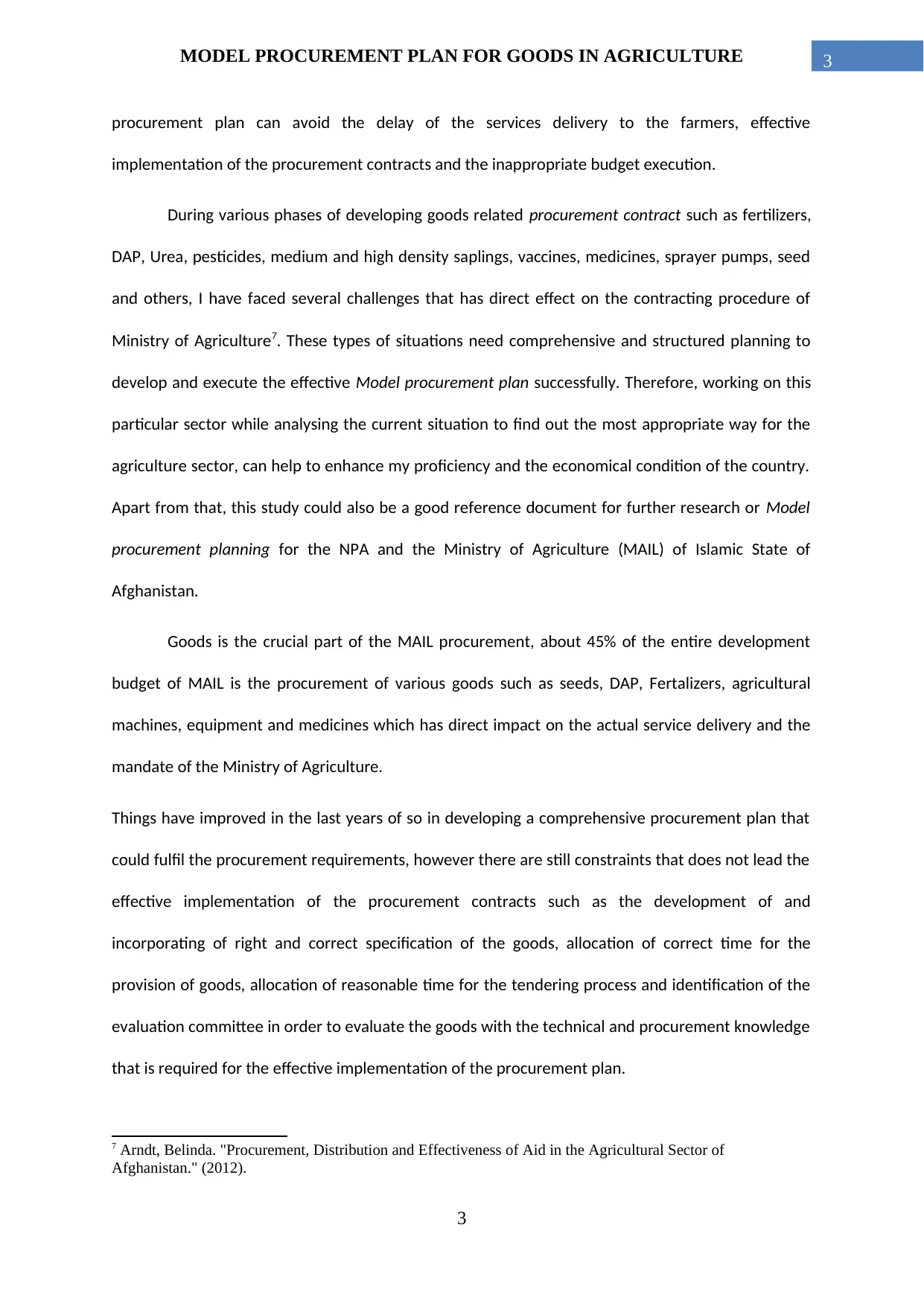
3MODEL PROCUREMENT PLAN FOR GOODS IN AGRICULTURE
procurement plan can avoid the delay of the services delivery to the farmers, effective
implementation of the procurement contracts and the inappropriate budget execution.
During various phases of developing goods related procurement contract such as fertilizers,
DAP, Urea, pesticides, medium and high density saplings, vaccines, medicines, sprayer pumps, seed
and others, I have faced several challenges that has direct effect on the contracting procedure of
Ministry of Agriculture7. These types of situations need comprehensive and structured planning to
develop and execute the effective Model procurement plan successfully. Therefore, working on this
particular sector while analysing the current situation to find out the most appropriate way for the
agriculture sector, can help to enhance my proficiency and the economical condition of the country.
Apart from that, this study could also be a good reference document for further research or Model
procurement planning for the NPA and the Ministry of Agriculture (MAIL) of Islamic State of
Afghanistan.
Goods is the crucial part of the MAIL procurement, about 45% of the entire development
budget of MAIL is the procurement of various goods such as seeds, DAP, Fertalizers, agricultural
machines, equipment and medicines which has direct impact on the actual service delivery and the
mandate of the Ministry of Agriculture.
Things have improved in the last years of so in developing a comprehensive procurement plan that
could fulfil the procurement requirements, however there are still constraints that does not lead the
effective implementation of the procurement contracts such as the development of and
incorporating of right and correct specification of the goods, allocation of correct time for the
provision of goods, allocation of reasonable time for the tendering process and identification of the
evaluation committee in order to evaluate the goods with the technical and procurement knowledge
that is required for the effective implementation of the procurement plan.
7 Arndt, Belinda. "Procurement, Distribution and Effectiveness of Aid in the Agricultural Sector of
Afghanistan." (2012).
3
procurement plan can avoid the delay of the services delivery to the farmers, effective
implementation of the procurement contracts and the inappropriate budget execution.
During various phases of developing goods related procurement contract such as fertilizers,
DAP, Urea, pesticides, medium and high density saplings, vaccines, medicines, sprayer pumps, seed
and others, I have faced several challenges that has direct effect on the contracting procedure of
Ministry of Agriculture7. These types of situations need comprehensive and structured planning to
develop and execute the effective Model procurement plan successfully. Therefore, working on this
particular sector while analysing the current situation to find out the most appropriate way for the
agriculture sector, can help to enhance my proficiency and the economical condition of the country.
Apart from that, this study could also be a good reference document for further research or Model
procurement planning for the NPA and the Ministry of Agriculture (MAIL) of Islamic State of
Afghanistan.
Goods is the crucial part of the MAIL procurement, about 45% of the entire development
budget of MAIL is the procurement of various goods such as seeds, DAP, Fertalizers, agricultural
machines, equipment and medicines which has direct impact on the actual service delivery and the
mandate of the Ministry of Agriculture.
Things have improved in the last years of so in developing a comprehensive procurement plan that
could fulfil the procurement requirements, however there are still constraints that does not lead the
effective implementation of the procurement contracts such as the development of and
incorporating of right and correct specification of the goods, allocation of correct time for the
provision of goods, allocation of reasonable time for the tendering process and identification of the
evaluation committee in order to evaluate the goods with the technical and procurement knowledge
that is required for the effective implementation of the procurement plan.
7 Arndt, Belinda. "Procurement, Distribution and Effectiveness of Aid in the Agricultural Sector of
Afghanistan." (2012).
3
⊘ This is a preview!⊘
Do you want full access?
Subscribe today to unlock all pages.

Trusted by 1+ million students worldwide
1 out of 62
Related Documents
Your All-in-One AI-Powered Toolkit for Academic Success.
+13062052269
info@desklib.com
Available 24*7 on WhatsApp / Email
![[object Object]](/_next/static/media/star-bottom.7253800d.svg)
Unlock your academic potential
Copyright © 2020–2025 A2Z Services. All Rights Reserved. Developed and managed by ZUCOL.





